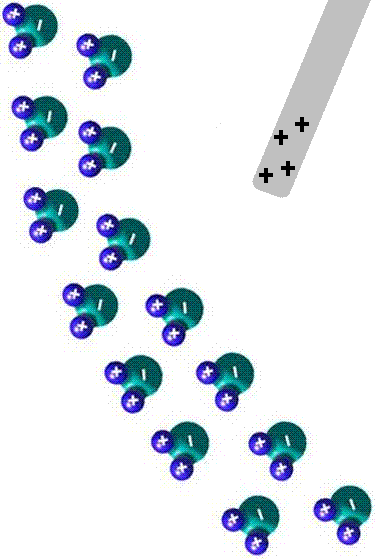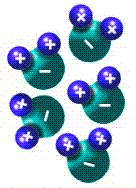Bending Water
Overview
Static electricity can be a problem whenever the humidity is low. It causes shocks and makes dust stick to surfaces, and it can literally make your hair stand on end. In this experiment, you will see that it also can move things around.
Equipment
- a nylon comb or a plastic toothbrush and a towel
- a water faucet
Safety
- No safety rules this time... Just dont eat the comb.
Procedure of experiment
- Run the comb through your hair several times, or alternatively rub the comb or toothbrush's hand grip with the towel for 30 seconds. At the same time, adjust the faucet to produce a small stream of water. Ideally the stream should be 1.5 millimeters in diameter.
- Slowly bring the teeth of the comb near the stream of water, about 8 to 10 centimeters (3 or 4 inches) below the faucet.
- Repeat the experiment, but now change the size of the stream by adjusting the faucet.
- Check whether you can get the same effect using another comb other equipment.
Explanation
 Electricity is a general term for the variety of phenomena resulting from the presence and flow of electric charge. Static electricity is the accumulation of an electrical charge in an object. The electrical charge develops when two objects are rubbed against one another. When thet"> objects are rubbed together, some electrons (charged components of atoms) jump from one object to the other. Since electrons are negatively charged, the object that loses the electrons becomes positively charged, while the object that they jump to becomes negatively charged. The nature of the objects has a large effect on how many electrons move. This determines how large an electrical charge accumulates in the objects. Hair and nylon are particularly good at acquiring charge when they are rubbed together.
Electricity is a general term for the variety of phenomena resulting from the presence and flow of electric charge. Static electricity is the accumulation of an electrical charge in an object. The electrical charge develops when two objects are rubbed against one another. When thet"> objects are rubbed together, some electrons (charged components of atoms) jump from one object to the other. Since electrons are negatively charged, the object that loses the electrons becomes positively charged, while the object that they jump to becomes negatively charged. The nature of the objects has a large effect on how many electrons move. This determines how large an electrical charge accumulates in the objects. Hair and nylon are particularly good at acquiring charge when they are rubbed together.
A charged object attract small particles, such as dust. The charge in the object causes a complementary charge to develop in something close to it. The complementary charge is attracted to the charged object. If the complementary charge forms on something tiny, such as dust particles, the force created is large enough to make these tiny particles move to the charged object. This is why your television screen becomes dusty faster than the television cabinet. When a television operates, electrons fly from the back to the screen. These electrons cause the screen to become charged. The charge on the screen attracts dust.
 The comb attracts the stream of water in the same way. The charge on the comb attracts the molecules of water in the stream. Because the molecules in the stream can be moved easily, the stream bends toward the comb. Because water molecules are polarized molecules, the effect is stronger than with dust. On the left picture, you can see water molecules in a random orientation, as in water. On the right side, the water stream is attracted towards the positively charged comb. The molecules orientate their dipoles, the negative oxygen towards the comb; the positively charged hydrogens away from it.
The comb attracts the stream of water in the same way. The charge on the comb attracts the molecules of water in the stream. Because the molecules in the stream can be moved easily, the stream bends toward the comb. Because water molecules are polarized molecules, the effect is stronger than with dust. On the left picture, you can see water molecules in a random orientation, as in water. On the right side, the water stream is attracted towards the positively charged comb. The molecules orientate their dipoles, the negative oxygen towards the comb; the positively charged hydrogens away from it.
When you comb your hair with a nylon comb, both the comb and your hair become charged. The comb and your hair acquire opposite charges. Because the individual hairs acquire the same charge, they repel each other. Perhaps you noticed that after running the nylon comb through your hair, the hairs on your head stood on end. This is a result of your hairs repelling each other because they are charged.
Static electricity is more of a problem when humidity is low. When humidity is high, most surfaces are coated with a thin film of water. When objects coated by a film of water are rubbed together, the water prevents electrons from jumping between the objects.
Previous Index Next
 Electricity is a general term for the variety of phenomena resulting from the presence and flow of electric charge. Static electricity is the accumulation of an electrical charge in an object. The electrical charge develops when two objects are rubbed against one another. When thet"> objects are rubbed together, some electrons (charged components of atoms) jump from one object to the other. Since electrons are negatively charged, the object that loses the electrons becomes positively charged, while the object that they jump to becomes negatively charged. The nature of the objects has a large effect on how many electrons move. This determines how large an electrical charge accumulates in the objects. Hair and nylon are particularly good at acquiring charge when they are rubbed together.
Electricity is a general term for the variety of phenomena resulting from the presence and flow of electric charge. Static electricity is the accumulation of an electrical charge in an object. The electrical charge develops when two objects are rubbed against one another. When thet"> objects are rubbed together, some electrons (charged components of atoms) jump from one object to the other. Since electrons are negatively charged, the object that loses the electrons becomes positively charged, while the object that they jump to becomes negatively charged. The nature of the objects has a large effect on how many electrons move. This determines how large an electrical charge accumulates in the objects. Hair and nylon are particularly good at acquiring charge when they are rubbed together. The comb attracts the stream of water in the same way. The charge on the comb attracts the molecules of water in the stream. Because the molecules in the stream can be moved easily, the stream bends toward the comb. Because water molecules are polarized molecules, the effect is stronger than with dust. On the left picture, you can see water molecules in a random orientation, as in water. On the right side, the water stream is attracted towards the positively charged comb. The molecules orientate their dipoles, the negative oxygen towards the comb; the positively charged hydrogens away from it.
The comb attracts the stream of water in the same way. The charge on the comb attracts the molecules of water in the stream. Because the molecules in the stream can be moved easily, the stream bends toward the comb. Because water molecules are polarized molecules, the effect is stronger than with dust. On the left picture, you can see water molecules in a random orientation, as in water. On the right side, the water stream is attracted towards the positively charged comb. The molecules orientate their dipoles, the negative oxygen towards the comb; the positively charged hydrogens away from it.